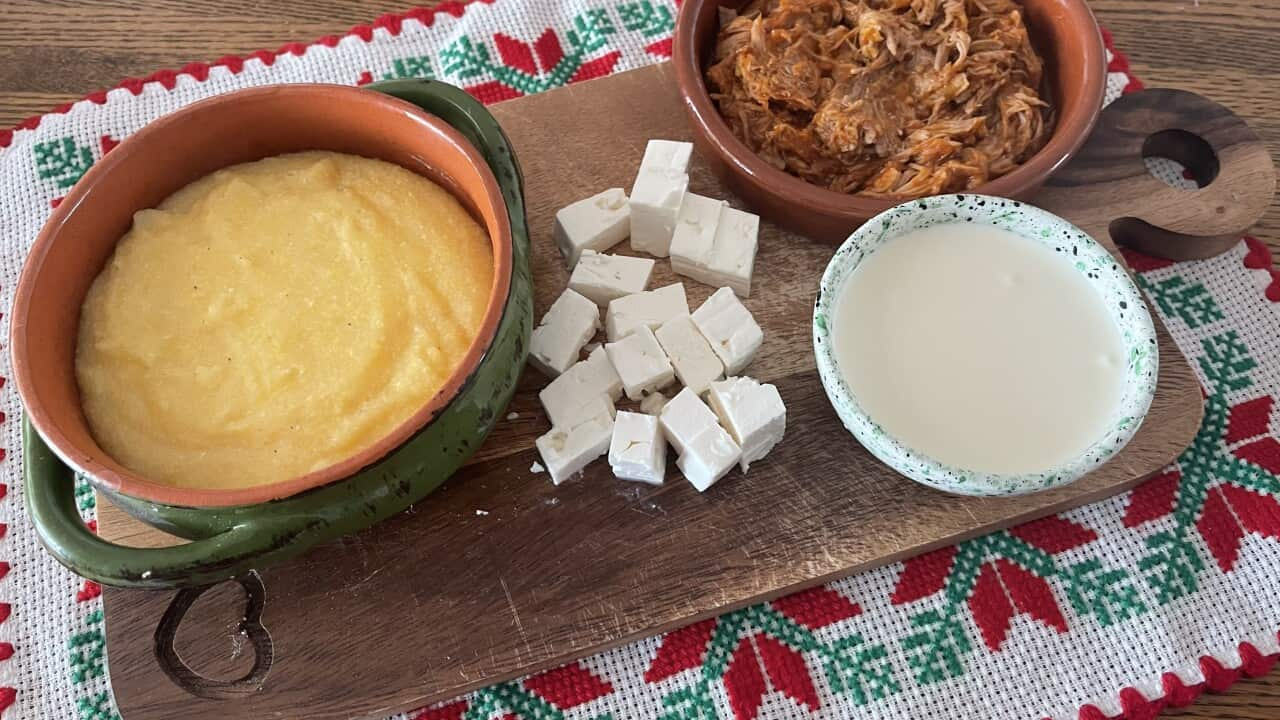"Ma-ma-liga, ma-ma-liga," sings my almost-four-year-old in a video I captured of her while she was eating the Romanian-kitchen staple mămăligă (məməˈliɡə).
She has but a handful of Romanian words in her vocabulary, and mămăligă is one of them. But it's not just any word.
Mămăligă is a quintessential staple not just in Romanian cuisine, but in Romanian culture. It's in our DNA. In mine, and now, in hers.
Mămăligă, Romania's version of polenta, is a porridge-like staple made of cornmeal. It's humble, peasant food that's found at every important event in the life of any Romanian: weddings, funerals, Christmas, Easter, etc. My daughter, now five, first tasted mămăligă when she was eight months old, just as she was foraying into solid foods. She liked it instantly, and her Romanian relatives took that not just as a pleasant coincidence, but as a sure sign that eating it was in her blood.
My daughter, now five, first tasted mămăligă when she was eight months old, just as she was foraying into solid foods. She liked it instantly, and her Romanian relatives took that not just as a pleasant coincidence, but as a sure sign that eating it was in her blood.

Steaming mămăligă. Source: Antoanela Safca
"Why do we eat so much mămăligă in Romania mummy?", she asked me the other day, and my limbs melted with pleasure. She had noticed that when we visit, almost every meal comes with a steaming side of it.
I was tempted to go on a romanticised explanation of our ancestors being kept alive by this unpretentious, humble food, but instead I stopped and said, "Because we like it. Isn't it good? Not many other people know about it, but for us it's very special."
And she nodded her agreement.
Not many other people know about it, but for us it's very special.
If I was tasting mămăliga for the first time, I don't know what my (I like to think) sophisticated palate would make of the water, salt and cornmeal porridge-like dish. But there's more than flavour to food, and for me, mămăliga bypasses my taste buds and pings some secret 'belonging buttons'. It tastes…cozy.
I liked mămăliga from day dot. My favourite way to have it was with a bowl of lightly salted milk. I would dunk spoonfuls of mămăliga dumplings into it.
After I moved to Australia, I craved mămăliga but never really learned how to cook it. We didn't have a ceaun, the small cast iron cauldron it's best cooked in. And I lacked the patience. It takes 20-30 minutes to cook, but instant polenta only take two minutes.
On my visits back to Romania, I ate it with almost every meal: mămăligă with stewed chicken liver, cheese and sour cream, sarmale, fried fish and Greek yogurt.
Now that my daughter is a fan, I've learned how to make it, and magically found the patience too.
The best way to eat mămăliga that I know is simply with a hard cheese, like feta or cheddar, and a dollop or two of sour cream. Another way is to use it to mop up the juices of whatever stew you have on hand. You could say that it's a bread substitute, but it's much more than that. Its grainy consistency adds a welcome texture to stews. Instant polenta varieties lack that texture, so if you want the real thing, you'll need to boil it slowly with a pinch of salt. You can cook it longer (up to 30 minutes) and let it firm into a cake-like texture, or keep it runny and moist (10-15 minutes), and pour it into a shallow bowl.
Instant polenta varieties lack that texture, so if you want the real thing, you'll need to boil it slowly with a pinch of salt. You can cook it longer (up to 30 minutes) and let it firm into a cake-like texture, or keep it runny and moist (10-15 minutes), and pour it into a shallow bowl.

Mămăligă served with pork and pickled peppers and cucumber. Source: Nadia Cranganu
Every family has its favourite way to serve it. I like it with a soft texture, but that's where my daughter and I part ways. She prefers a firm version.
There are many foods my child won't eat. Many Romanian foods at that. But for some reason, she loves mămăligă. And I can see how its carby nature might appeal to a kid. The texture is good too. The taste is a comforting saltiness. It's easy to like. And yet, I like to think there's more to her liking it than all of that.
Mămăligă
Makes 4
Ingredients
- 4 cups water (add or subtract 1 cup, depending on how many people you're cooking for)
- 3 cups cornmeal (not instant polenta)
- A generous dash of salt
Method
- Boil the water with the salt in a heavy cast iron pot.
- When the water boils, start adding the cornmeal, very slowly, mixing all the time. Keep an eye on the consistency. You want it to be very runny, like a porridge.
- Once you have your desired consistency, let it boil on low for another 15-20 minutes, making sure it doesn't thicken too much. If it does, add a little more boiling water and mix.
- Pour the mixture into a wide, shallow bowl and serve steaming hot with a stew, or with feta cheese, sour cream and a fried egg.
Notes
- You're more likely to find cornmeal in European or Mediterranean grocery stores. The polenta mix readily available in supermarkets won't do this dish justice.
- In Romania, people place mămăligă in the centre of the table and use it as a base for every dish, from starters to the main meal. Fold it through hard feta cheese and sour cream for a starter. Have it with stew, fried fish or traditional meat cabbage rolls, sarmale, for a main.





